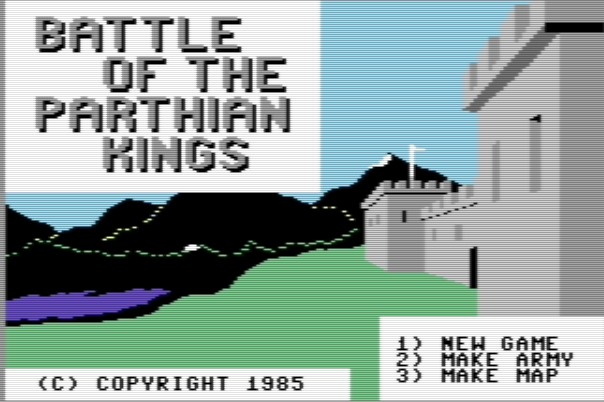
We diving back into Parthian Kings ! Last time, I defeated 3 rivals thanks to the power of my wizard who went all “be fruitful, multiply and pay taxes” on my main city. This felt like an exploit, and so I decided to offer the computer a rematch — a duel free from magical influence, with a 20-turn time limit.
The first order of business is to create a map. Following instructions from commentator Dayyalu, I tasked ChatGPT to design an ASCII map, which I subsequently built within the game.
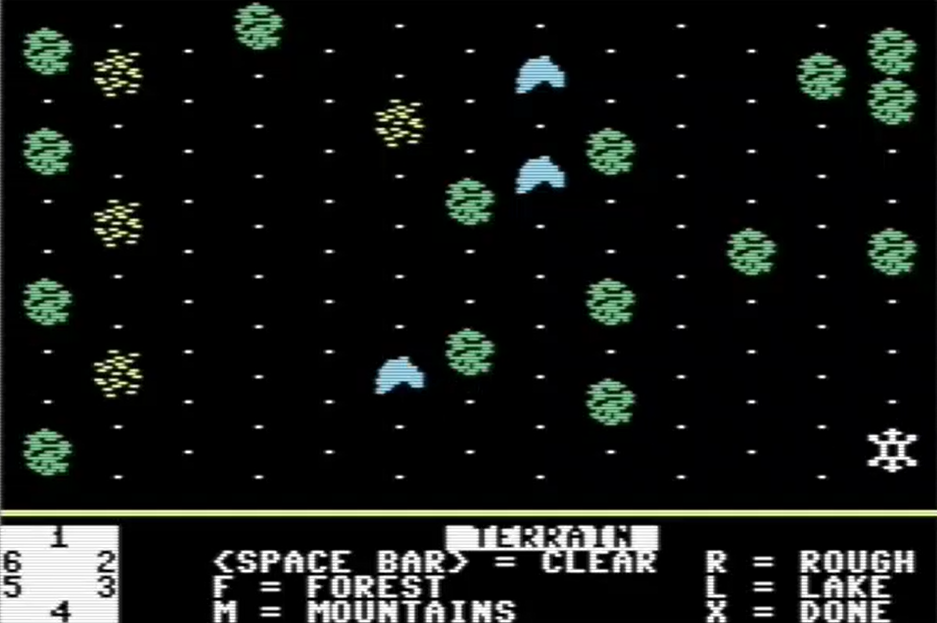
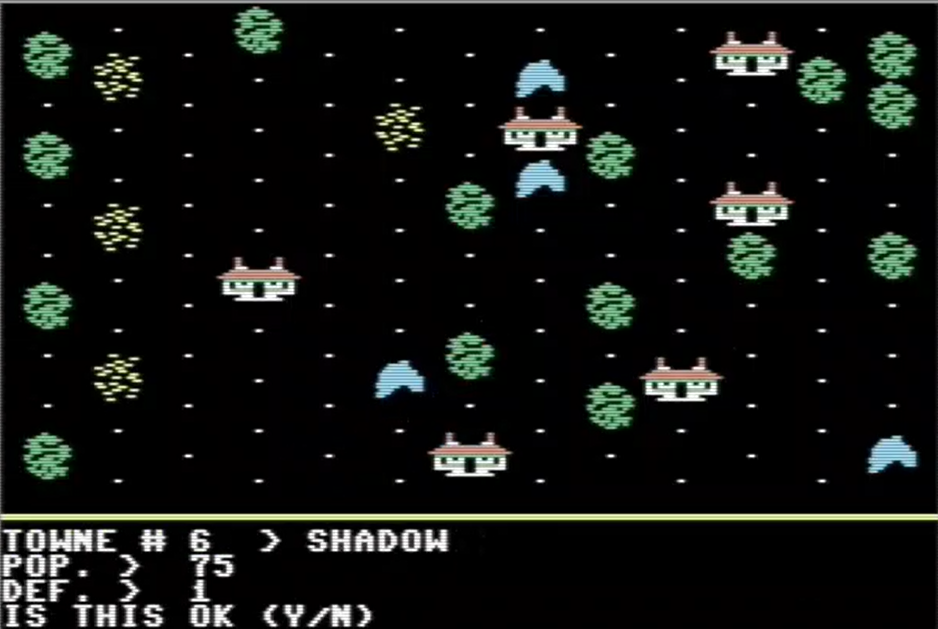
Once the map is over, I design a new army, this time thematically based on the Vikings, since I know that computer #1 is always King Alfred.
Based on the experience of my first AAR, I go for a different strategy. I create one swift, inexpensive unit (the scout), whose sole function is to occupy the vacant cities early on and secure a lake tile. The remaining units are designed for sheer power, sharing similar primary attributes such as health points and strength :
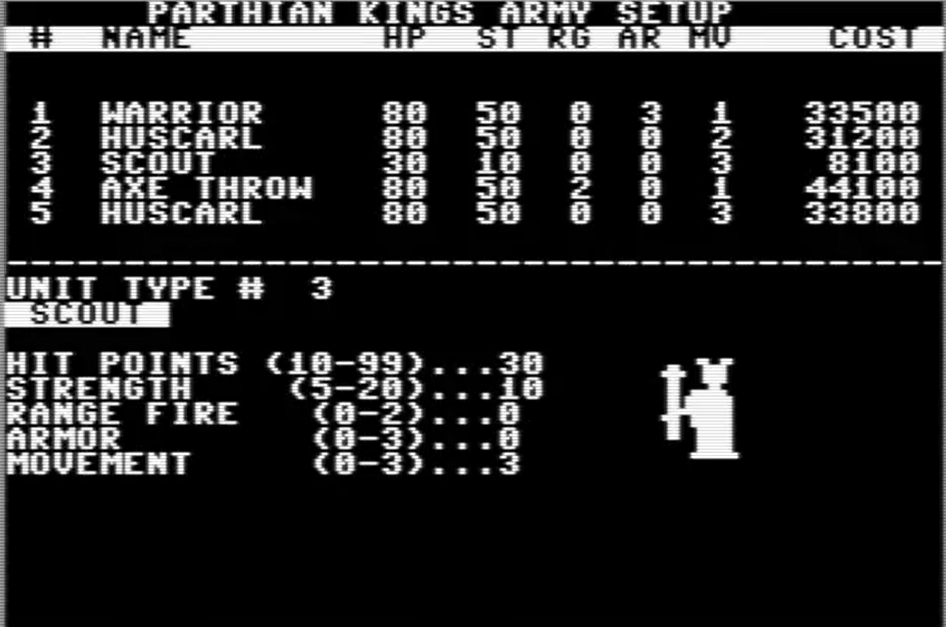
- The Warrior is the slow-but-armoured variant for garrison duty,
- The Axe Thrower is the ranged version. The game makes range attacks extremely expensive for what ends up being a marginal advantage, and I don’t plan to use them, but you never know,
- The Huscarl will be my main combat unit, with a speed of two and nothing else special,
- The Huscarl is a faster variant, with a speed of three.
Yes, that’s two Huscarls. I initially intended to name one of them “Berserkers”, and then forgot which name I had already used, which caused the mix-up.
As we set up the battle, the computer chooses the city nestled between two lakes ; a good choice – its strategic positioning provides it with easy bonus victory points. Meanwhile, I pick on purpose the worst city in terms both defence and starting population : Shadowglen in the South. I deploy four scouts : two are assigned to the Southern lakes, and two to the southern cities. One of them, Ironhill on the West, lies equally distant to Alfred and me. As movements are resolved simultaneously, I know we will reach it the same turn and that the stronger army will keep the city, so with all my remaining funds, I purchase a group of five speedy Huscarls.

The initial two turns unfold as expected. The computer claims the two eastern cities, while I capture the one to my east. We reach Ironhill at the same time, but my Huscarls overpower Alfred’s forces. I promptly spend my cash to purchase as many Warriors as possible in Ironhill, and then adjust the tax rate to 5% so the tired, poor, huddled mass yearning for tax breaks come to me.
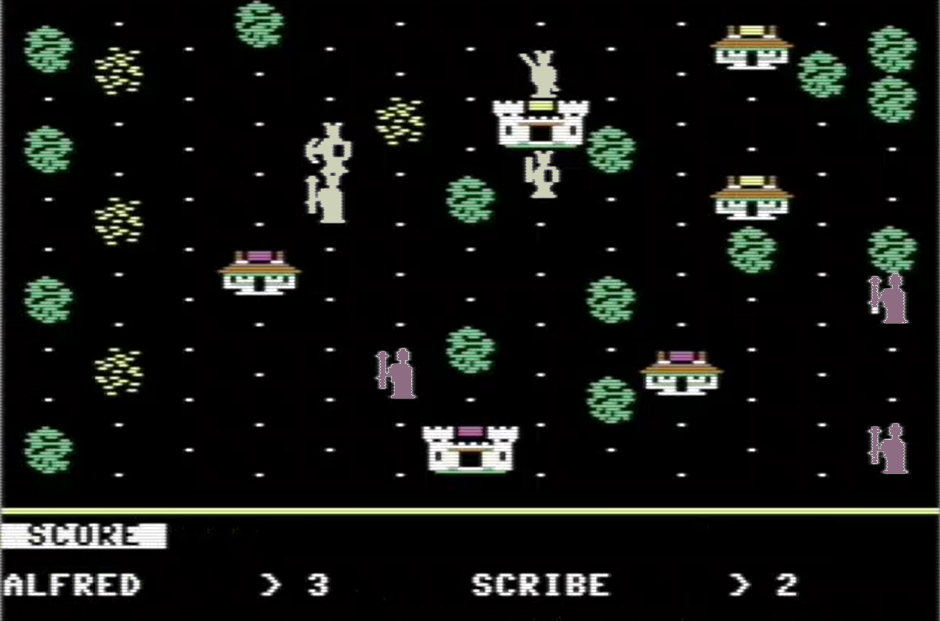
There are 4 ways to gain points in Parthian Kings :
- Holding lakes (1 point / turn),
- Destroying caravans (5 points),
- Killing an enemy King (25 points),
- Killing an enemy wizard (10 points) – each of us has one even though they can’t cast spells in this game,
Because there are only 2 lakes on my side and it took me 2 turns to reach one of them, Alfred has an advantage of 1 point. The wizard and the King have no reason to leave their castle, so I need to occupy the enemy lakes – a dangerous mission since the enemy castle will then be able to shoot at my units. Still, I have to do it. I send 4 fast Huscarls and hold one of the enemy lakes for 2 turns :
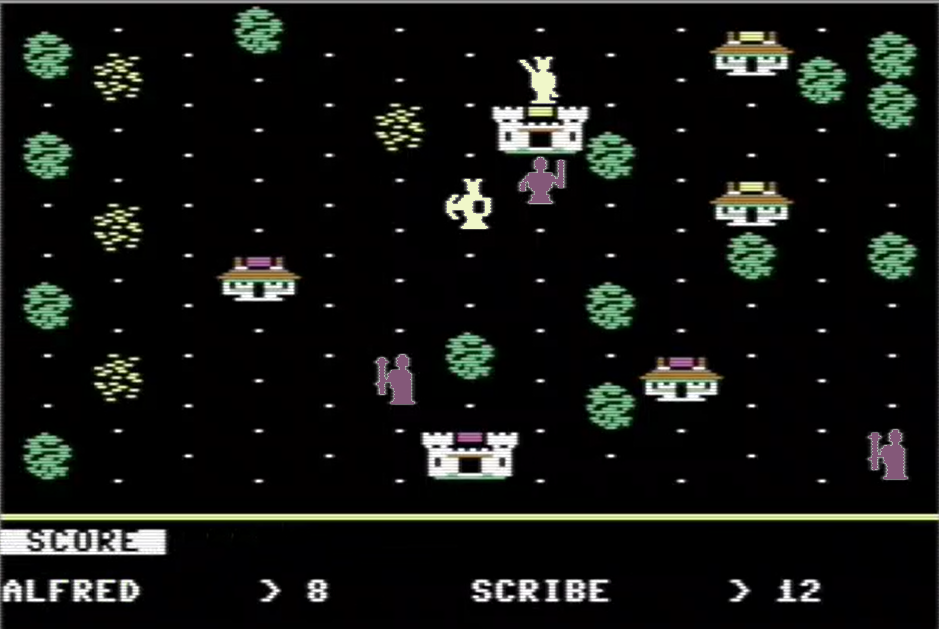
That turns out to be useless. A few turns later, my opponent sends a caravan toward Ironhill. Caravans allow to deploy units remotely, but if attacked the units they contain defend poorly. Some newly created fast Huscarls destroy it, giving me 5 extra points.

Following this, the game descends into a calm standoff. My opponent continuously launches attacks on my cities, without success. Meanwhile, I am steadily amassing population and troops, as I lose very few Warriors in defence. Starting from turn 12, I raise the tax rate again, which, given my high population, results in a significant cash inflow.
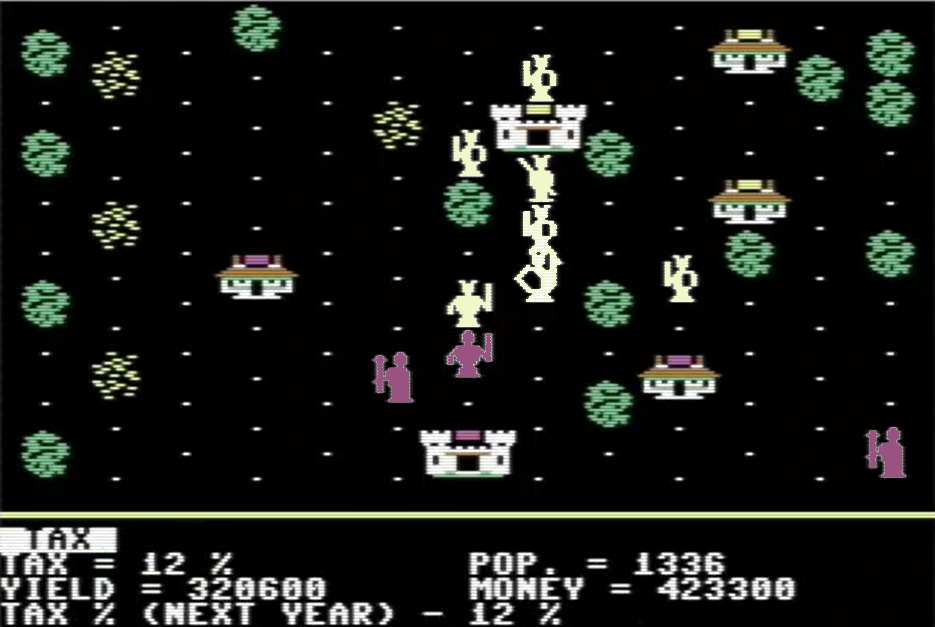
By turn 14, I am ready for the final assault. I amass a massive, albeit slow, Huscarl army in the east, and launch it toward the nearest enemy city : Riverwood!
Unfortunately…
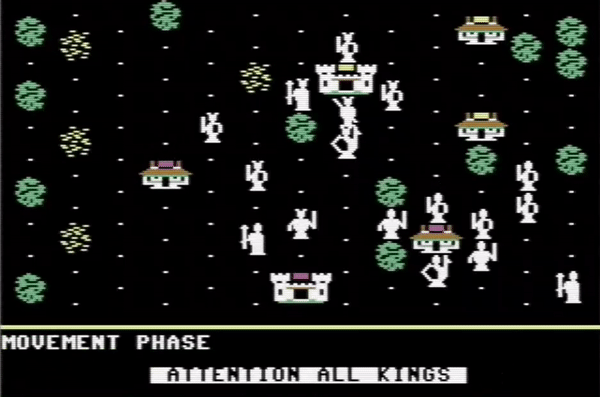
This time, my opponent attacked Shadowglen, my main city, with a huge Warlord stack – his elite unit. He succeeds in taking my capital, killing my King, Wizard, and a stationed caravan in the process. This sudden twist awards him 40 points ! To compound my difficulties, I can’t build anywhere until I regain control of my starting city.
With no time to reverse course, my only way is forward : my massive army stands a solid chance of sweeping through everything my opponent has in the north. In a desperate bid, I also order a sortie from my southern garrison to try to recapture Shadowglen.
As expected, I conquer Riverwood with minimal losses – just two units of slower Huscarls.
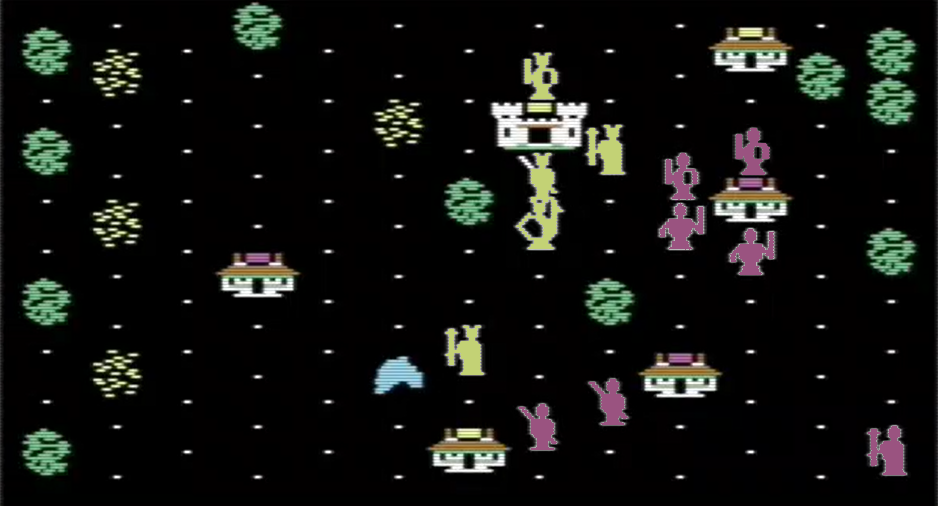
More surprisingIy, my opponent had not garrisoned Shadowglen, enabling me to retake it with ease. Now, with several turns worth of cash at my disposal, I invest in a gargantuan army in Riverwood.
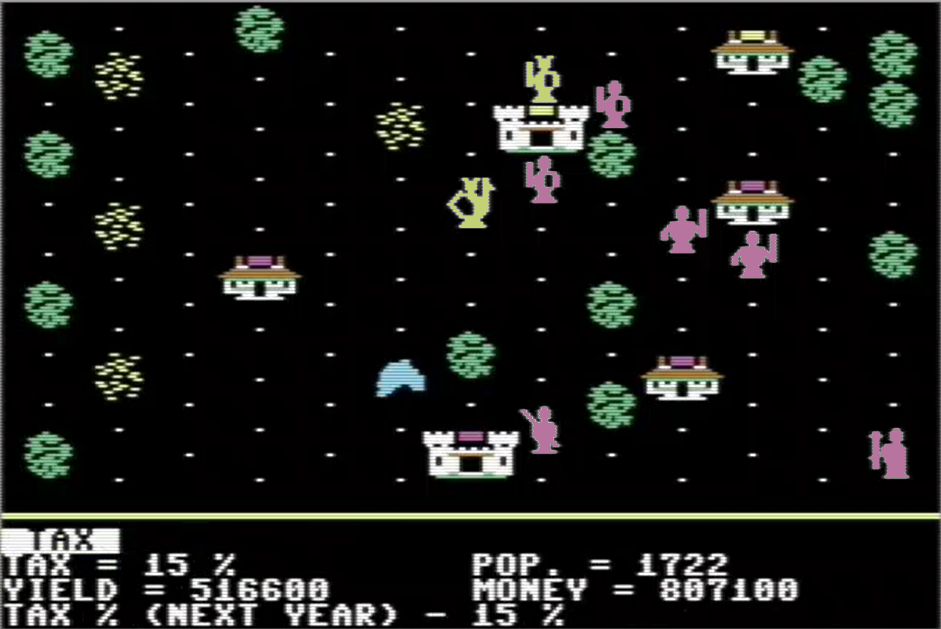
With that, I easily take the two last enemy cities, killing King Alfred and his Magi Chaplain.
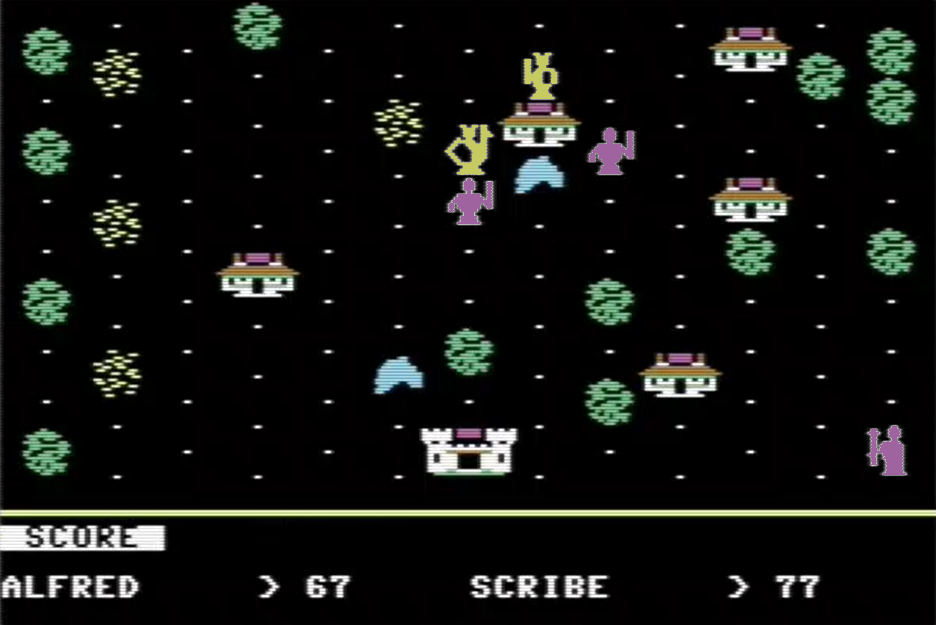
I have to spend one more turn killing the last enemy survivors, and receive a disappointing “Pyrrhic Victory” end screen. I guess having been killed counts as “Pyrrhic” indeed.

I don’t regret giving the game a second chance. It was easy, but more interesting than my first game.
Ratings & Review
Parthian Kings by David W. Bradley, published by Avalon Hill, USA
First release : Late 1983 (Apple II)
Tested on : Apple II emulator (AppleWin) and Commodore Emulator (Vice)
Total time tested : Three and half hours
Average duration of a campaign: 1-2 hours for a long campaign
Complexity: Simple (1/5)
Would recommend to a modern player : No
Would recommend to a designer : No
Final Rating: Well-designed but obsolete
Ranking at the time of review : 22/96
Summary :
Parthian Kings is one of the first games of the “fantasy strategy” genre, and given the lack of references and the lack of experience of its designer it is surprisingly well-designed, with an unparalleled level of customization for its time, extending to aspects like units, maps, and game rules. But like many games that tried to explore new design directions, it lacks depth and suffers from the comparison with all the games which later occupied its niche.
Parthian Kings is David W. Bradley’s first game. Bradley is relatively well-known as the main designer of the Wizardry series after Wizardry IV but also for the way he talks about himself and more generally his grandiloquent prose, a trait he must have developed after Parthian Kings. Bradley rarely mentions his debut game, and all I found is an interview for IGN in 2001. He claims that he learned to program on mainframe while in College studying music. He initially wanted to be able to play his own scores, but the temptation was too great not to also program games, something that was forbidden and got him booted from the computer room. Undeterred, he carried on coding on an Apple II+. Here is his version of what happened next :
Fortunately, I happened to chance upon a fellow working in a local computer store who knew some business people desperate for special computer programs, and voila! The next thing you know we were in business together – he made all the money and I did all the work. My, how little things have changed, ha ha ha… By day I’d write all kinds of business applications – banking, medical, communications, database, inventory, blah-blah you name it – and at night I’d work on one of my games. Avalon Hill published Parthian Kings when I finished it around 1981.
1981 seems early given the game was not released before late 1983, but it is probably an honest mistake. I would take the rest of the testimony with a pinch of salt.
While Bradley is sometimes mocked for talking as if he invented computer RPGs, it can’t be denied that Parthian Kings, his only foray into strategy games, is innovative. Still, he did not quite invent this subgenre of wargame (2X for eXpand an eXterminate ?), and I see two multiplayer-only precursors he possibly used for inspiration :
- Warlords by Speakeasy Software in 1978 (!). Jason Dyer from Renga in Blue brought my attention to this game a few weeks ago, for unrelated reasons, and I found out it has a remarkable number of similarities with Parthian Kings. Warlords‘s pitch is about a King dying and his four warlords fighting for supremacy, each warlord/player starts with one city and must try to take the other cities by moving units on a map (which is using squares and not hexagons) and, telltale detail, both games have the odd usage of the word “division” to describe the number of “soldiers” a unit has. It has significant differences too, all squares are owned and pay taxes, and units can be built anywhere.
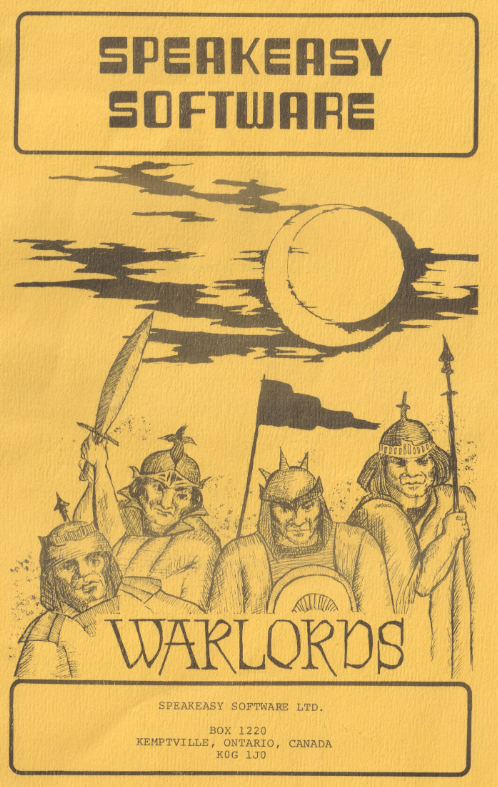
- Conquest of Chesterwoode by Adventure International (1981) is even more similar to Parthian Kings. In Chesterwoode, players can set tax levels, movements are planned and then solved in a random order, it has terrain type, random events, … Again, Chesterwoode uses “divisions” for the “soldiers” in a unit.

My educated guess is that the designers of Conquest of Chesterwoode knew about Warlords, and that Bradley was aware of either Warlords or Chesterwoode, if not both. It is also possible there was a board game out there they all drew inspiration from. In any case, Parthian Kings has enough key differences with both of those precursors (in particular the magic and the unit creation) that I cannot consider it a clone or even a copy – so let’s rate it :
A. Immersion
Terrible.
B. UI, Clarity of rules and outcome.
Poor. The game is easy to play, but it is really challenging to see which units belong to whom – not great for a strategy game. It fails at “clarity of rules”- after two full games I still don’t understand how combat works – I just used the most powerful units I could afford in my first game, and dodged the issue by making all my non-scout units equally powerful in the second one.
I am very mixed about the fact that you have no information about the enemy units, not even their numbers. One could claim that it adds an element of tactics, with deception and probing attacks, but imagine seeing an enemy Panzer III in Panzer General, and not knowing if there is 1 or 9 of them, and if it is really a Panzer III or actually just infantry or maybe a Flak-88 – that’s how it feels. If only one piece of information was hidden, it would create interesting strategies as you try to “read” your opponent’s units. Since both are hidden, you have no way to know whether the weakness of the enemy is due to its number or its specs. Mitigant : the AI plays fair, in that its units look like what they are. In multiplayer of course, it will be absolute chaos.
C. Systems
Poor. The game works but the game lacks depth : its economy is overly simplified and the tactical part falls short.
- For the economy, I wish in particular that the cities did not pool their resources : as it is the caravans are almost useless and it is easy to snowball ; once you take a city you can immediately build massive defences,
- For the tactical part, I would have loved terrain to have more impact (but then maybe it has more than I think and I never noticed because I don’t understand combat), right now the strategy is all about creating large armies of your strongest unit and beelining toward the closest enemy.
D. Scenario design & balancing
Quite good. Army customization, unit customization, the option to play with or without magic, choice of the number of enemies, choice of game duration, AND a decent AI – few games offered this in 1983. Of course, the AI is not decent but not great, the map is too small for my taste and I wish the unit creator had a few more options – like dedicated archers rather than just melee units that happen to attack at range.
E. Did I make interesting decisions
Sometimes, mostly of a “should I attack now or later” nature.
F. Final rating
Well-designed but obsolete. I had one OK session and then one fun session, but the lack of depth of both the economic and tactical layers of the game does not entice me to launch a third solitaire game – I have seen everything there is to see and I have no new strategy to test. Parthian Kings was probably a blast to play in 1983, but now its subgenre is home to some of the best wargames in the history of gaming, including the Warlords series, the Age of Wonders series and the first four Heroes of Might and Magic. None of those classics were inspired even indirectly by Parthian Kings, which to my knowledge without obvious progeny.
Contemporary Reviews
Parthian Kings received rave reviews for its unique blend of tactics and economy. For instance, Curtis Edward writing for Computer Gaming World reckons in April 1984 that Parthian Kings is “a good example of the new crop of military games with a fantasy setting, Parthian Kings has those features which should ensure that you will continue to play it for a long time to come.” The 1986 Book of Apple Software gives Parthian Kings a B+ rating, stating that the game is “never boring”. I could not find any article that would not praise the level of customization found in Parthian Kings and many also praised the adequacy (at the minimum) of the AI, albeit always with the additional comment that it was also horribly slow to play.
The game seems to have been particularly a blast in multiplayer, with several reviews commenting on it, for instance Family Computing in May 1984 (“Younger playtesters ages 12 and up took it on its most basic level, while older testers engaged in some fancy political double-crossing and double-dealing) or Neil Shapiro writing for Electronic Games in July 1984 : “this game [is]an absolute natural for computer clubs to investigate for tournaments. For multiple-player capabilities, this is just about the best.” In Byte Magazine in May 1985, Jerry Pournelle comments “I haven’t had time to play [Parthian Kings], but I note that the boys have spent a good bit of time playing, both against each other and against the machine.” Maybe Parthian Kings will make a third return on this blog, but as a multiplayer game ? We’ll see.
Edit 23/12/2023: I came back to Parthian Kings in multiplayer after all.